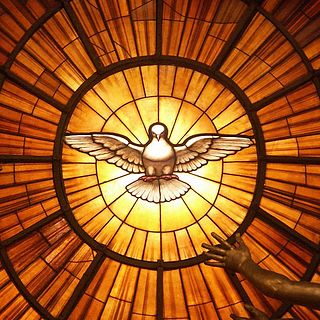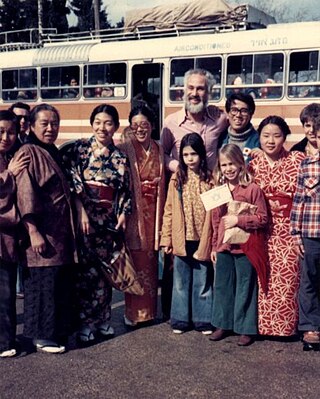To be born again, or to experience the new birth, is a phrase, particularly in evangelicalism, that refers to a "spiritual rebirth", or a regeneration of the human spirit. In contrast to one's physical birth, being "born again" is distinctly and separately caused by the operation of the Holy Spirit, and it occurs when one is baptized in water. It is a core doctrine of the denominations of the Anabaptist, Moravian, Methodist, Baptist, Plymouth Brethren and Pentecostal Churches along with all other evangelical Christian denominations. All of these Churches strongly believe Jesus's words in the Gospels: "You must be born again before you can see, or enter, the Kingdom of Heaven". Their doctrines also mandate that to be both "born again" and "saved", one must have a personal and intimate relationship with Jesus Christ.
Pentecostalism or classical Pentecostalism is a Protestant Charismatic Christian movement that emphasizes direct personal experience of God through baptism with the Holy Spirit. The term Pentecostal is derived from Pentecost, an event that commemorates the descent of the Holy Spirit upon the Apostles and other followers of Jesus Christ while they were in Jerusalem celebrating the Feast of Weeks, as described in the Acts of the Apostles.
The Third Great Awakening refers to a historical period proposed by William G. McLoughlin that was marked by religious activism in American history and spans the late 1850s to the early 20th century. It influenced pietistic Protestant denominations and had a strong element of social activism. It gathered strength from the postmillennial belief that the Second Coming of Christ would occur after mankind had reformed the entire Earth. It was affiliated with the Social Gospel movement, which applied Christianity to social issues and gained its force from the awakening, as did the worldwide missionary movement. New groupings emerged, such as the Holiness movement and Nazarene and Pentecostal movements, and also Jehovah's Witnesses, Spiritualism, Theosophy, Thelema, and Christian Science. The era saw the adoption of a number of moral causes, such as the abolition of slavery and prohibition.

Uchimura Kanzō was a Japanese author, Christian evangelist, and the founder of the Nonchurch Movement (Mukyōkai) of Christianity during the Meiji and Taishō periods in Japan. He is often considered to be the most well-known Japanese pre-World War II pacifist.
Oneness Pentecostalism is a nontrinitarian religious movement within the Protestant Christian family of churches known as Pentecostalism. It derives its name from its teaching on the Godhead, a form of Modalistic Monarchianism commonly referred to as the Oneness doctrine. The doctrine states that there is one God―a singular divine spirit with no distinction of persons―who manifests himself in many ways, including as Father, Son, and Holy Spirit. This stands in sharp contrast to the doctrine of three distinct, eternal persons posited by Trinitarian theology.
In Christian theology, baptism with the Holy Spirit, also called baptism in the Holy Spirit or baptism in the Holy Ghost, has been interpreted by different Christian denominations and traditions in a variety of ways due to differences in the doctrines of salvation and ecclesiology. It is frequently associated with incorporation into the Christian Church, the bestowal of spiritual gifts, and empowerment for Christian ministry. Spirit baptism has been variously defined as part of the sacraments of initiation into the church, as being synonymous with regeneration, or as being synonymous with Christian perfection. The term baptism with the Holy Spirit originates in the New Testament, and all Christian traditions accept it as a theological concept.

The Catholic Charismatic Renewal (CCR) is a movement within the Catholic Church that is part of the wider charismatic movement across historic Christian churches.
Christian perfection is the name given to a process of achieving spiritual maturity or perfection and is a theological concept that exists within many sects of Christianity. The ultimate goal of this process is union with God characterized by pure love of God and other people as well as personal holiness or sanctification. Other terms used for this or similar concepts include entire sanctification, perfect love, the baptism with the Holy Spirit, the indwelling of the Holy Spirit, baptism by fire, the second blessing, and the second work of grace.

Makuya, based at the Tokyo Bible Seminary, is a religious movement in Japan which was founded in 1948 by Ikurō Teshima. To grasp the inner truth of biblical religion, or the "Love of the Holy Spirit" as Teshima puts it, and extol this existential love by embodying it and living accordingly is the essence of the Makuyas' religious life.
Abraham Ikurō Teshima was the founder of the Makuya religious movement. A native of Kumamoto, Japan, he was baptized as a Protestant at the age of fifteen, and soon afterwards joined the Nonchurch Movement started by Uchimura Kanzō. Teshima was influenced by Uchimura's writings, studying under his disciple Tsukamoto Toraji and later joining the Nonchurch Movement. Other religious figures that made a great impact upon Teshima's belief and religiosity include Toyohiko Kagawa, Sadhu Sundar Singh, and Martin Buber.
In Christian theology, good works, or simply works, are a person's (exterior) actions and deeds that align with the moral teachings, emphasizing compassion, charity, kindness and adherence to biblical principles, in contrast to inner qualities such as grace or faith. Rooted in the belief that faith should manifest in positive actions, the concept underscores the importance of living out one's faith through generosity. Adherents emphasize the significance of engaging in altruism as a demonstration of their devotion to God. These actions, guided by the moral and ethical teachings of the Bible, are viewed as tangible expressions of love, obedience and righteousness within the framework of the Christian worldview. The concept of good works is intricately linked to the theological belief in salvation through faith rather than a means of earning salvation, as Christians seek to manifest their gratitude for God's grace by actively participating in acts of service to others. This theological perspective places significance on the transformative power of good works in fostering a life reflective of Christian values. Christians are often encouraged to love their neighbors, care for the unfortunate, and promote moral values in their communities.
The Spirit of Jesus Church, was registered in 1941 in Japan by Murai Jun. The church was named in accordance with a heavenly vision he reportedly received in 1941. The core mission of the Spirit of Jesus Church, is defined in the Gospel of Mark 16:15-18. There he instructed his disciples to preach the gospel and baptize the believers, and promised the power to perform miracles, cast out demons, speaking in tongues, and heal the sick. It is one of the fastest-growing Christian bodies in Japan, having increased its membership from 34,477 in 1970 to 433,108 at the end of the 1980s. Taken at face value, the Spirit of Jesus Church is one of the largest New religious movements in Japan. They also reject the Trinitarian doctrine and claims to be the only true Christian church in the world
The Japan Ecclesia of Christ is an independent Japanese church that was founded by Koike Tasuo (小池辰雄) in 1940. Koike Tatsuo was born in 1904 and educated in Tokyo Imperial University. He became attracted to Christianity as a young man as a result of attending the Bible lectures of Uchimura Kanzō, the well-known founder of the Nonchurch movement. After his conversion, he attended a Nonchurch Bible study group led by Takeshi Fujii, one of Uchimura's disciples, for a period of five years (1925–1930). in 1940 Koike established his own independent Bible study group based on the Nonchurch tradition. Over the next twelve decades, Koike's circle of influence widened and he eventually organized twelve groups around the country.
The Holy Ecclesia of Jesus also known as the Congregation of Jesus is an independent Japanese Christian denomination founded by Ōtsuki Takeji (大槻武二) in 1946. It is the third largest of the Japanese-founded churches. The Holy Ecclesia of Jesus is a movement aimed at recovering apostolic Christianity and entrusted with a special mission regarding the nation of Israel in these "last days." Ōtsuki writes that its authentic mission is not to transmit the doctrine or theology of Christianity, but to manifest the living Christ in our lives. As of 2007, the movement had approximately 5,000 members throughout Japan.
Ōtsuki Takeji was the founder of the third largest independent Japanese church, known as the Holy Ecclesia of Jesus. Ōtsuki was born in Ayabe City in 1906, and as a young man converted to Christianity while a student at Dōshisha Middle school, a private mission school in Kyoto. Ōtsuki was attracted to the faith through the evangelistic preaching of Kanamori Michinori during the daily chapel program and went on to receive baptism. Dissatisfied with Dōshisha's "liberal and socialistic" form of Christianity, Ōtsuki found his way into the Japan Holiness Church in 1930. Ōtsuki completed his theological training at the Holiness Bible Seminary in Tokyo and engaged in evangelistic work in several locations around Japan before accepting appointment as a missionary to Manchuria in 1936.

The following outline is provided as an overview of and topical guide to Christianity:
Protestant theology refers to the doctrines held by various Protestant traditions, which share some things in common but differ in others. In general, Protestant theology, as a subset of Christian theology, holds to faith in the Christian Bible, the Holy Trinity, salvation, sanctification, charity, evangelism, and the four last things.
Charismatic Christianity is a form of Christianity that emphasizes the work of the Holy Spirit and spiritual gifts as an everyday part of a believer's life. It has a global presence in the Christian community. Practitioners are often called Charismatic Christians or Renewalists. Although there is considerable overlap, Charismatic Christianity is often categorized into three separate groups: Pentecostalism, the Charismatic movement, and the Neo-charismatic movement.
Evangelical theology is the teaching and doctrine that relates to spiritual matters in evangelical Christianity and a Christian theology. The main points concern the place of the Bible, the Trinity, worship, Salvation, sanctification, charity, evangelism and the end of time.



